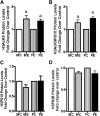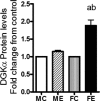Binge Alcohol Is More Injurious to Liver in Female than in Male Rats: Histopathological, Pharmacologic, and Epigenetic Profiles
- PMID: 31262967
- PMCID: PMC6695503
- DOI: 10.1124/jpet.119.258871
Binge Alcohol Is More Injurious to Liver in Female than in Male Rats: Histopathological, Pharmacologic, and Epigenetic Profiles
Abstract
Binge alcohol consumption is a health problem, but differences between the sexes remain poorly defined. We have examined the in vivo effects of three acute, repeat binge alcohol administration on the liver in male and female rats. Sprague-Dawley rats were gavaged with alcohol (5 g/kg body weight) three times at 12-hour intervals. Blood and liver tissues were collected 4 hours after the last binge ethanol. Subsequently, several variables were analyzed. Compared with male rats, females had higher levels of blood alcohol, alanine aminotransferase, and triglycerides. Liver histology showed increased lipid vesicles that were larger in females. Protein levels of liver cytochrome P4502E1 were higher in the liver of females than in the liver of males after binge. Hepatic phospho-extracellular signal-regulated kinase 1/2 and phosph-p38 mitogen-activated protein kinase levels were lower in females compared with males after binge alcohol, but no differences were found in the phospho-C-jun N-terminal kinase levels. Peroxisome proliferator-activated receptor γ-coactivator 1α and cyclic AMP response element binding (CREB) protein levels increased more in female than in male livers; however, increases in phospho-CREB levels were lower in females. Remarkably, c-fos was reduced substantially in the livers of females, but no differences in c-myc protein were found. Binge ethanol caused elevation in acetylated (H3AcK9) and phosphoacetylated (H3AcK9PS10) histone H3 in both sexes but without any difference. Binge alcohol caused differential alterations in the levels of various species of phosphatidylethanol and a larger increase in the diacylglycerol kinase-α protein levels in the liver of female rats compared with male rats. These data demonstrate, for the first time, similarities and differences in the sex-specific responses to repeat binge alcohol leading to an increased susceptibility of female rats to have liver injury in vivo. SIGNIFICANCE STATEMENT: This study examines the molecular responses of male and female rat livers to acute binge alcohol in vivo and demonstrates significant differences in the susceptibility between sexes.
Copyright © 2019 by The American Society for Pharmacology and Experimental Therapeutics.
Figures







References
-
- Apte M, McCarroll J, Pirola R, Wilson J. (2007) Pancreatic MAP kinase pathways and acetaldehyde. Novartis Found Symp 285:200–216. - PubMed
-
- Aradottir S, Asanovska G, Gjerss S, Hansson P, Alling C. (2006) PHosphatidylethanol (PEth) concentrations in blood are correlated to reported alcohol intake in alcohol-dependent patients. Alcohol Alcohol 41:431–437. - PubMed
-
- Aroor AR, Custer GW, Weng YI, Lee YJ, Shukla SD. (2002) Phosphotidylethanol mimics ethanol modulation of p42/44 mitogen-activated protein kinase signalling in hepatocytes. Alcohol Alcohol 37:534–539. - PubMed
Publication types
MeSH terms
Substances
Grants and funding
LinkOut - more resources
Full Text Sources
Research Materials
Miscellaneous

